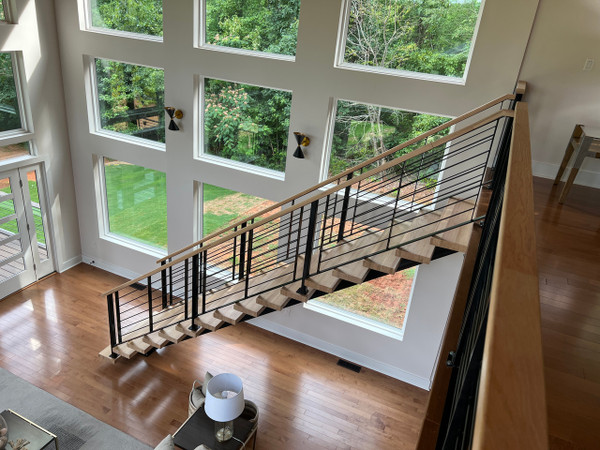Floating Stair Railings and Tread Count: A Modern Design Guide
Posted by Peter on Aug 28th 2025
Floating stairs have become a hallmark of modern architecture — sleek, open, and minimalistic. While their beauty is undeniable, the details make all the difference. From the railing system that ensures safety to the tread count that defines comfort and proportion, every choice impacts both form and function.
Materials and Finishes for Floating Stair Railings
The choice of material for your railing can dramatically shift the personality of a floating staircase. Glass railings emphasize transparency and allow natural light to flow, making small spaces feel larger. Steel or aluminum railings deliver strength and a sharp, industrial look that pairs well with modern interiors. Wood handrails introduce warmth and can soften the minimalism of floating stairs, bridging contemporary and traditional design. Even finishes matter — matte black is bold and architectural, while brushed stainless steel feels timeless and low-maintenance. Selecting the right material and finish helps ensure your floating stairs feel intentional and cohesive with the rest of your space.
Why Floating Stair Railings Matter
The railing system is more than just a safety requirement; it’s part of the design language of your home or project. Whether you prefer slim steel balusters, clear glass panels, cable railings, or warm wood handrails, the railing should strike the right balance between visibility, safety, and style.
A good floating stair railing should:
-
Provide security and support without overpowering the airy design
-
Comply with building code requirements for height and spacing
-
Complement the tread material (wood, steel, concrete, or stone)
-
Enhance the modern, open feel rather than close it in
Understanding Tread Count
Tread count simply refers to the number of steps in your staircase. It’s calculated by dividing the total floor-to-floor height by the riser height of each step. For floating stairs, tread count has both functional and aesthetic consequences.
-
Too few treads → Steps are taller and harder to climb, which can feel unsafe.
-
Too many treads → Each step is shallow, making the staircase overly long and visually heavy.
-
The balance → Most modern floating staircases end up with 12–16 treads, depending on ceiling height and layout.
Balancing Style and Safety
Floating stairs are loved for their light, sculptural appearance, but safety is always a priority. Railings should be engineered to handle real-world force, while tread dimensions must follow code. In most regions, that means around 7 inches for riser height and 10–11 inches for tread depth.
Railings offer another layer of design choice:
-
Glass or cable railings keep the view open and highlight the “floating” effect.
-
Steel or iron railings create bold architectural lines.
-
Wood accents add warmth to balance modern materials.
Floating staircases are a statement piece, but their success depends on the details. Railings define the look and ensure safety, while tread count determines comfort and compliance. By paying attention to both, you can create a staircase that is not only practical but also a centerpiece of modern design.
